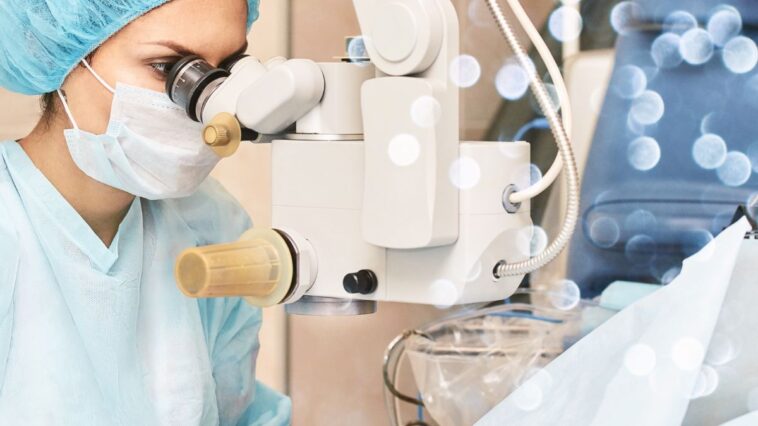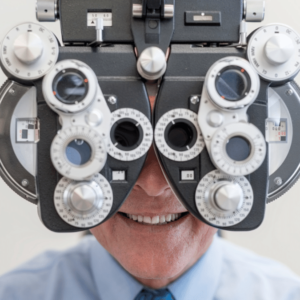What is PRK Surgery?
PRK (Photorefractive Keratectomy) surgery is a type of refractive surgery that is used to correct vision problems caused by refractive errors such as myopia (nearsightedness), hyperopia (farsightedness), and astigmatism.
During the PRK procedure, the surgeon uses a laser to reshape the cornea, which is the clear front part of the eye, to change its focusing power. This is done by removing a small amount of tissue from the cornea’s surface. By altering the shape of the cornea, the laser allows light to focus more accurately on the retina, improving vision.
Unlike LASIK surgery, which involves creating a flap on the cornea and reshaping the underlying tissue, PRK removes only the cornea’s surface layer, so there is no need to create a flap. This makes PRK a good option for people with thin corneas or other corneal abnormalities that make LASIK unsuitable.
How Long Does PRK Surgery Take?
PRK surgery is relatively quick, usually taking 10 to 15 minutes per eye. However, the exact time can vary depending on various factors, such as the patient’s prescription, the type of laser used, and the surgeon’s experience.
During the PRK procedure, the patient is typically given local anesthesia to numb the eye and reduce discomfort. The surgeon then uses a laser to remove the cornea’s surface layer, reshaping it to correct the refractive error causing vision problems. After the procedure, a soft contact lens may be placed on the eye to protect the cornea and aid in healing.
While PRK is relatively quick, allowing plenty of time for preparation and recovery is essential. Before the procedure, the patient will need to undergo a comprehensive eye examination and meet with the surgeon to discuss the risks and benefits of the surgery. After the procedure, the patient must take some time off work or other activities to allow the eyes to heal properly.
Overall, the entire PRK process, from the initial consultation to the final post-operative appointment, can take several weeks to a few months, depending on the individual’s healing process.
PRK Recovery Timeline
The recovery time after PRK surgery can vary from person to person, but generally, it takes several weeks to recover fully. You may experience discomfort, light sensitivity, and blurred vision the first few days after the procedure. You must take some time off from work or other activities to allow your eyes to heal.
Here is a rough timeline of what you can expect during PRK recovery:
- Day 1-3: You may experience pain, discomfort, and blurry vision during the first few days. You must wear a protective contact lens to help your eyes heal.
- Week 1-2: You may start to see some improvement in your vision, but it may still be blurry or hazy. You may still experience some discomfort and sensitivity to light.
- Week 3-4: Your vision will continue to improve, and you may be able to return to some normal activities. However, your vision may still be slightly blurry, and you may experience some dryness and sensitivity to light.
- Month 1-3: Your vision will continue to stabilize and improve during this time. You may still experience some dryness and sensitivity to light, but most people can return to normal activities by this point.
Following your eye doctor’s instructions carefully during recovery ensures smooth and successful healing. This may include using eye drops, avoiding certain activities, and attending follow-up appointments with your eye doctor.
What Should I Expect During Post-Operative Healing and Recovery?
After PRK surgery, following your doctor’s instructions carefully is vital to ensure a smooth and successful recovery. Here is what you can generally expect during the post-operative healing and recovery period:
- Discomfort and Blurry Vision: You may experience discomfort, redness, and sensitivity to light in the first few days after surgery. You may also experience blurry vision or haze during this time.
- Eye Drops: You must use prescribed eye drops several times a day for several weeks after surgery to help prevent infection, reduce inflammation, and promote healing.
- Contact Lens: Your eye doctor may place a soft contact lens over the cornea to protect and help it heal. This contact lens is usually removed within a few days to a week after surgery.
- Avoiding Certain Activities: You may need to avoid certain activities, such as swimming, for a few weeks after surgery to prevent infection and avoid accidentally rubbing your eyes.
- Follow-Up Visits: You must attend follow-up appointments with your doctor to monitor your healing progress and ensure your vision improves.
- Vision Improvement: Your vision will gradually improve over several weeks to several months. Some patients may experience fluctuations in vision during the healing process, but this is usually temporary.
- Final Results: The outcome of PRK surgery can take up to six months to fully stabilize, although most patients experience significant vision improvement within the first month.
It is important to remember that everyone’s healing process is different, and your doctor will provide specific instructions based on your situation. Be patient and carefully follow your doctor’s instructions to ensure a successful recovery and optimal vision correction.
PRk Recovery Time Tips for Quicker Healing
Here are some tips that may help speed up your PRK recovery time and promote quicker healing:
- Rest Your Eyes: During the first few days after PRK surgery, it’s essential to rest your eyes as much as possible. This means avoiding reading, watching TV, or using electronic devices. You can still move around and do light activities, but avoid anything that requires intense visual focus.
- Use Prescribed Eye Drops: Eye drops help to reduce inflammation, prevent infection, and keep your eyes lubricated. Follow your doctor’s instructions for using eye drops carefully, and use them as prescribed.
- Wear Sunglasses: After PRK surgery, your eyes may be light-sensitive. Wear sunglasses to protect your eyes from bright sunlight and glare outside.
- Avoid Rubbing Your Eyes: Rubbing your eyes can irritate and delay healing. If you have an itch, gently tap or press the eyelid to relieve it.
- Stay Hydrated: Drinking plenty of water and fluids can help keep your eyes and body hydrated, which is vital for healing.
- Avoid Certain Activities: Avoid swimming, using hot tubs, or participating in contact sports for at least a few weeks after surgery. Also, avoid dusty or dirty environments as much as possible.
- Attend Follow-Up Appointments: Attend all your follow-up appointments with your doctor to ensure that your eyes are healing properly and your vision is improving as expected.
- Be Patient: The recovery time after PRK surgery can vary from person to person. Be patient, follow your doctor’s instructions carefully, and give your eyes time to heal correctly.
Overall, following your doctor’s instructions carefully and taking good care of your eyes during recovery is essential. Doing so can help promote quicker healing and achieve the best possible results from your PRK surgery.
Are there any Potential Complications from Undergoing PRK Surgery?
As with any surgical procedure, PRK surgery carries potential risks and complications, although they are rare. Here are some of the potential complications that can occur:
- Undercorrection or Overcorrection: In some cases, PRK may result in an under-correction or overcorrection of your vision. This can be corrected with additional procedures or glasses or contacts.
- Infection: There is a risk of developing an infection after PRK surgery, which can lead to vision loss if not treated promptly. It’s important to follow your doctor’s instructions carefully for using antibiotic eye drops to prevent infection.
- Haze: Some patients may experience cloudy cornea, which can cause blurred vision. This is more common in people with high refractive errors and can usually be treated with steroid eye drops.
- Dry Eyes: After PRK surgery, your eyes may experience dryness, which can cause discomfort and even affect your vision. Using artificial tears and other lubricating eye drops can help manage this symptom.
- Glare and Halos: Glare and halos may be experienced by some patients, especially during nighttime when looking at lights. However, this is generally a temporary side effect that often resolves as the eyes heal over time.
- Regression: In some cases, the vision correction achieved through PRK may not last permanently and may require additional procedures, glasses, or future contacts.
It’s important to discuss the potential risks and complications of PRK surgery with your doctor before undergoing the procedure. Your eye doctor can help you determine if PRK is a safe and appropriate option for your needs and can guide you to minimize your risk of complications.
Conclusion
In conclusion, PRK surgery is a type of refractive surgery used to correct vision problems such as nearsightedness, farsightedness, and astigmatism. The procedure involves removing the cornea’s outer layer and reshaping the underlying tissue with a laser to improve vision.
PRK surgery offers many benefits, such as permanent vision correction, no risk of flap complications, and suitability for people with thinner corneas. However, it also carries potential risks and complications such as under or overcorrection, infection, haze, dry eyes, glare, halos, and regression.
To ensure a successful outcome, following your doctor’s instructions carefully and attending all follow-up appointments is essential.
Contact your eye doctor immediately if you have concerns or experience unusual symptoms during recovery.






